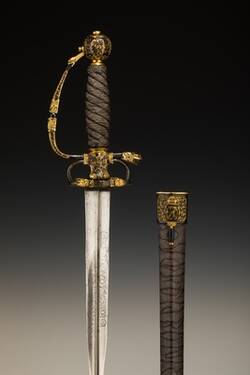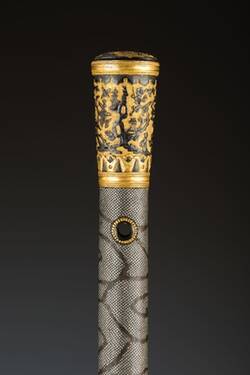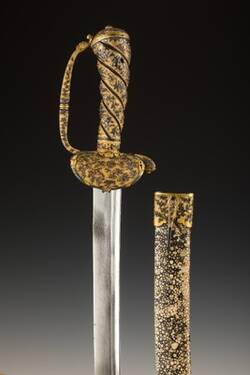A set consisting of sword and cane, plus a hunting hanger with a slightly curved blade. In the 18th century, an ensemble like this one was an essential accoutrement for any sovereign with an eye for fashion. These sophisticated objects were made by Japanese artisans for the European market.
This set is special, because it was made in what’s known as the elaborate shakudō technique, which was developed in Japan. It features a characteristic colour palette of black and gold. The raised areas of black display typically Japanese motifs: branches bearing blossoms, landscapes, birds, and three-dimensional dragons’ heads.
Exotic materials were used for the covers of both the cane and the sheaths. They were made from the skins of sharks and rays. The ornamental patterns were achieved by a skilful blend of decorative polishing and urushi lacquer. The familiar European forms of the cane, sword and hunting-dagger were combined with striking and alien Japanese designs, which turned these items into sought-after fashion accessories. The set is thought to have been a gift from the Russian Czar Peter the Great to August the Strong.
The Dutch East India Company exported Japanese shakudō objects to Europe. During his first trip to Europe in 1697, Peter the Great worked on a ship at their Amsterdam dockyard. The company’s large warehouse was very close by, and the Czar, with his inquiring mind, was no doubt fascinated and inspired by the wide range of goods kept there.
Further Media
- Location & Dating
- Japanese. C. 1700.
- Material & Technique
- Wood, shark- or snakeskin (?) polished; Knob and ferrule: copper alloy (Sawasa/Shakudo), polished and punched, partly gilded, black varnish.
- Dimenions
- Total length 104.5 cm Knob length 5.5 cm Diameter 2.9 cm Weight 184 g
- Museum
- Rüstkammer
- Inventory number
- i. 0505




